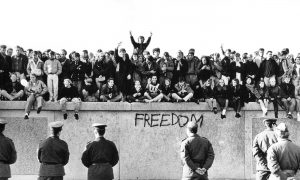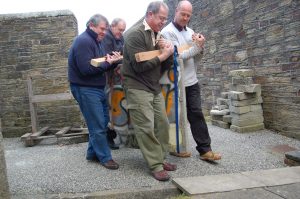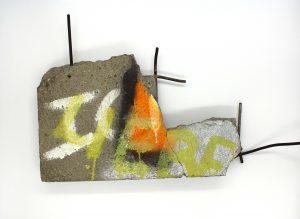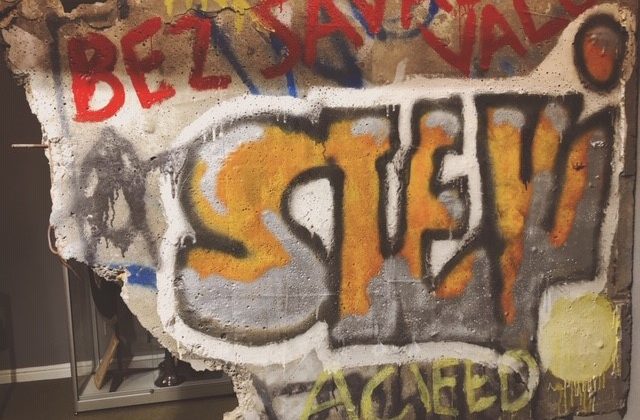30 Years since the Fall of the Berlin Wall

November 9th 2019 marked the 30th anniversary of the Fall of the Berlin Wall. it was a pivotal moment in history which set in motion a chain of events which led to the reunification of Germany and the end of the Cold War.
The Brandenburg Gate symbolised freedom and the desire to unify the city of Berlin, so on 9 November 1989 thousands of people gathered at the Brandenburg Gate to celebrate the fall.
Crowds of East & West Germans scrambled to climb onto the Wall and cross over it in an act of triumphant defiance.

A Large Souvenir
Over the next few weeks, everyone became souvenir hunters and chipped away parts of the Wall. We have a large piece on permanent display in the museum here in Bodmin.
The piece in the museum collection comes from a small village on the outskirts of the city, where there was less of a police presence and therefore it was much easier to use the wall as a canvas for graffiti.

Read more about how this large piece came to be in Cornwall!
On 22 December 1989, the Brandenburg Gate border crossing was re-opened when Helmut Kohl, the West German chancellor, walked through to be greeted by Hans Modrow, the East German prime minister.
The demolition of the Wall officially began on 13 June 1990 and was completed in November 1991. The “fall of the Berlin Wall” paved the way for German reunification, which formally took place on 3 October 1990.
Eastern Bloc Emigration Restrictions
After World War II, emigration restrictions were imposed by countries in the Eastern Bloc, and after East Germany tightened its zonal occupation border with West Germany, the city sector border between East Berlin and West Berlin became a loophole through which defection could occur. This resulted in Berlin becoming a magnet for East Germans desperate to escape life in the communist state of the German Democratic Republic (GDR).
Before the Wall’s erection, 3.5 million East Germans were able to utilise the ‘Berlin loophole’ and cross the border and escape to West Germany and other Western European countries, which was proving a problem with the East German Authorities;
“the presence in Berlin of an open and essentially uncontrolled border between the socialist and capitalist worlds unwittingly prompts the population to make a comparison between both parts of the city, which unfortunately does not always turn out in favour of Democratic [East] Berlin.” Soviet East German ambassador Mikhail Pervukhin
The Brain Drain
The people fleeing the GDR tended to be young and well-educated and by 1960, the combination of World War II and the massive emigration westward left East Germany with only 61% of its population of working age, compared to 70.5% before the war. The loss was disproportionately heavy among professionals: engineers, technicians, physicians, teachers, lawyers and skilled workers.
The so-called brain drain of professionals had become so damaging to the political credibility and economic viability of East Germany that the re-securing of the German communist frontier was imperative.
On Saturday, 12 August 1961, the leaders of the GDR attended a garden party at a government guesthouse in the north of East Berlin. There, Ulbricht signed the order to close the border and erect a wall.
‘Barbed Wire Sunday’
Barbed Wire Sunday is the name given to Sunday morning on August 13 1961, when the military and police of East Germany began the construction of what would become of the Berlin Wall, with the sole purpose of preventing citizens of East Germany migrating to the West. The Brandenburg Gate border crossing was closed the next day.
The Berlin Wall had officially been established. Berlin went from being the easiest place to make an unauthorised crossing between East and West Germany to being the most difficult.
The Wall Goes Up
The Berlin Wall was an 87-mile-long, heavily-guarded concrete block wall imposing a physical barrier to divide Berlin politically and ideologically. It was the physical embodiment of the “Iron Curtain” that separated Western Europe and the Eastern Bloc during the Cold war.
The wall was indiscriminate; families were split, East Berliners employed in the West were cut off from their jobs and West Berlin became an isolated enclave in a hostile land.
Between 1961 and 1989 the Wall prevented almost all emigration. The wall was heavily guarded by 48,000 border guards, 500 watch towers and minefields. In the first year 30 people died trying to cross the wall and in the 28 years of its existence and despite a further 150 people being killed, over 14,000 people did manage to escape to the West.

This year we’re pleased to have been able to loan the smaller piece of the Berlin Wall from the Museum’s collection to Sky Creative for an exhibition celebrating 30 years of Sky News, and the big stories they have reported on. This exhibition will be held at Sky UK in Osterley from mid-November.
Want to hear more?
Watch Voices of the Light Infantry – Berlin Wall
Listen to ‘Bodmin Keep War Stories’ Podcast – The Berlin Wall

